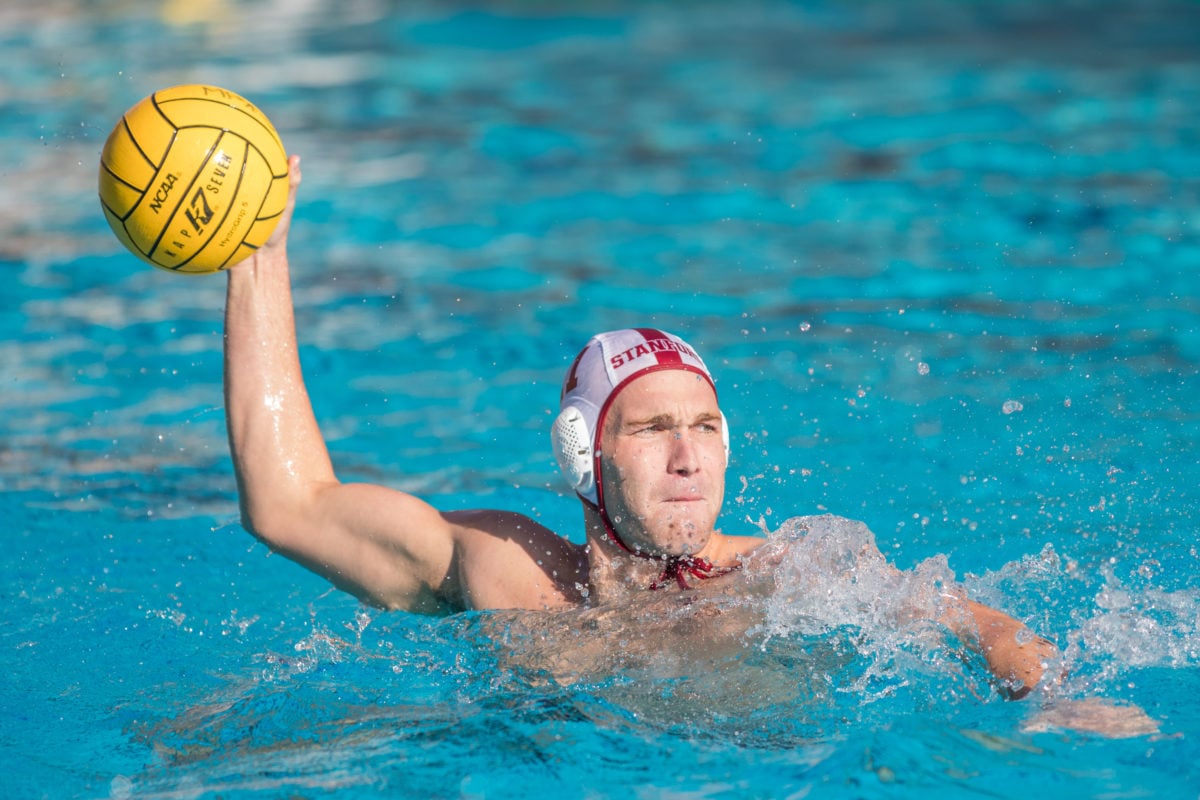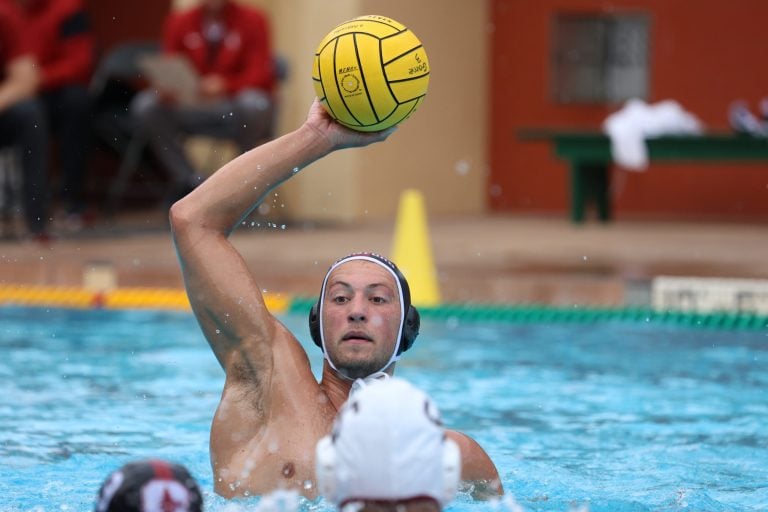This year in men’s water polo has been a rollercoaster ride. For the first time in program history, the team played two full seasons in a single calendar year.
Due to the ongoing COVID-19 pandemic, the NCAA postponed the fall sport’s 2020 season until the winter, so Stanford men’s water polo team uncharacteristically played from February to March this year. Then just five months later, they were in the pool again to begin their regularly scheduled 2021 season.
The condensed schedules altered the year for the players and presented unique mental and physical challenges.
“It’s been really hard. It’s been almost a year of uninterrupted [play] — no offseason — really hard, pretty strenuous practices and stuff like that,” 2MD AJ Rossman said about the altered schedule. “So it definitely gets a little hard to stay motivated, because the burnout is pretty real.”
“But it’s also been interesting,” the co-captain added. “Having two seasons back-to-back is very weird because I feel like I just played games that I’m playing a week ago, and that was last season.”
For example, the Cardinal have faced UCLA a whopping seven times since February — the most recent match-up resulting in a Stanford loss in the 2021 MPSF tournament final.
Two goal game thanks to Quinn Woodhead. Keep fighting. #GoStanford pic.twitter.com/D55tY65d8g
— Stanford Men's Water Polo (@StanfordMWP) November 21, 2021
Despite the toll of playing 36 games in a nine-month span amid a pandemic, both Rossman and Quinn Woodhead have shone this year. Although the Cardinal was stopped just short of an NCAA run this season, the duo led Stanford to a 19-6 overall record, and individually, Rossman and Woodhead claimed All-MPSF first and second team honors, respectively.
But what the awards and statistics obscure is the bumpy path that the seniors have traversed over the last year. Just a year ago, the Stanford team did not even know if they would have a season — much less two deep conference title runs.
At the start of the pandemic — when campus first closed in March 2020 — Rossman returned home to Orange County, where public health–related closures made high-level training near impossible. With public pools shut down indefinitely, he was out of the water for the longest span in over a decade.
“There was a lot of cross-training and lifting weights — gave my body a little rest,” he said.
“A lot of us transitioned to running or just dryland workouts,” senior driver and co-captain Quinn Woodhead said. “Swimming is very weird in that you get out of shape very quickly. So being out of the pool for three or four months and then trying to get back into it was really difficult at the beginning.”
When restrictions began to loosen, Rossman swam in the only body of water he could: the Pacific Ocean.
When the water polo team was finally able to return to campus last year, practice looked different, too. While the county-mandated precautions were necessary to keep the team safe, the restrictions also gave rise to additional complications and distractions for a team already uncertain of their future. In Rossman’s words, “COVID just presented a lot of obstacles.”
At one point, the Cardinal were tested nine times per week. While the players would take off their masks in the pool during practice, they needed to put them back on while sitting on the bench — a “not fun” task when your body is dripping wet.
To make matters more challenging, for a while the team could not practice with contact, a tough feat for a sport that is highly physical. Instead, the players worked on only swimming, passing and shooting.
“It’s really hard to get better at water polo without playing, scrimmaging and actually getting reps,” Woodhead said.
Nevertheless, despite a timeline in flux and socially distanced practice sessions, the water polo team persisted.
“We all lived together as a team, hung out together, trained together — kind of 24/7,” Woodhead said. “So one of the bright things that came out of the COVID training was we spent a lot of time together. I feel that I’m very close with my team, even the underclassmen. So that was definitely a plus.”
Nearly 14 months after winning the NCAA championship on December 8, 2019, the Cardinal returned to action on February 6, 2020, with a No. 1 ranking and a win over then-No. 2 USC to start the fall-2020-turned-winter-2021 season on a high note. After a month, the Cardinal won their third straight MPSF title but were unable to repeat as NCAA champions after falling in the semifinals to UCLA.
Yet, there was little time to process the 2020-21 season. Still limited by COVID precautions, the team returned over the summer to train again.
“It just kind of feels like one big season,” Rossman said about the accelerated schedule.

But the 2021 season was a welcome return to some semblance of normalcy. Woodhead downplayed the physical demands because “we’re kind of used to playing year round”; instead, he recalled his excitement at the prospect of “playing with fans and real games, traveling to other schools.”
“You can kind of see how people have gotten more into it this season — just being able to scrimmage and get that time in the pool together,” Woodhead said about his teammates.
This sense of joy and gratitude pushed the Cardinal to a 12-game win-streak at the start of the 2021 season, but Stanford’s momentum fizzled when MPSF play began, which proved to be the Cardinal’s Achilles’ heel. Despite winning every single non-conference game this season (including eight games against Top-10 opponents), Stanford did not pick up a conference win until the postseason MPSF tournament.
“There were some bumps early in the season, but I think that comes with a young team and comes with learning,” Woodhead said in October. “I’m excited about how much we’ve improved already.”
Momentum seemed to be shifting in the Cardinal’s favor when they upset No. 1 Cal in the MPSF semifinals, but Stanford ultimately fell by just one point to UCLA in the finals. The Cardinal’s poor conference record (0-3), however, kept them from the NCAA tournament for the first time since 2017.
At times throughout the season, Stanford’s relative inexperience has been on display — but for Rossman and Woodhead, the Cardinal’s youth is also a benefit for the future. Although the duo will both graduate and leave Stanford this spring, the Stanford water polo pipeline is loaded.
A player to keep an eye on? Rossman says it is 2M Ike Love.
“He’s 6-foot-7, ginger, huge,” Rossman said. “And he’s a center — he’s the big guy in front of the cage. And generally, big guys like Ike don’t have great hands, but he’s a very smart guy and has great hands. He’s a sophomore right now, and I think he’ll be going places.”
“I’m excited to see how [junior driver] Larsen [Weigle] continues playing this year,” Woodhead said. “My sophomore year, when we won the [NCAA] championship, he definitely had a coming off the bench roll — just bringing some quick offense. And now that he’s kind of a solidified starter, I’m excited to see what he can do in the full games. I think he’s already shown that he’s a great water polo player, but I really don’t think he’s reached his full potential yet.”
If all goes to plan, men’s water polo won’t take the pool again until fall 2022. Unlike 2021, the Cardinal will get a true offseason to regroup, reflect and reload.
For the 2022 season, head coach John Vargas and the Cardinal will have something to prove. The Stanford men have overcome the odds of the strange, disorderly COVID year, and they’ll use that same resilience to eventually come out on top once again.
